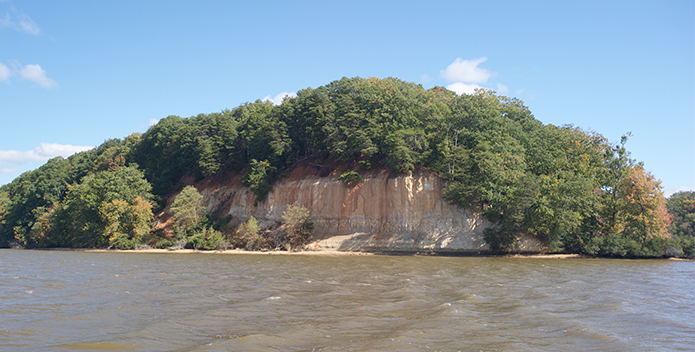There are few places like Fones Cliffs left in the Bay watershed. A jewel on Virginia's Rappahannock River, Fones Cliffs is home to a diverse array of wildlife. But this year, the critters at Fones Cliffs will find a changed landscape on the Northern Neck.
Several months ago a developer illegally cleared 13.5 acres of trees from atop these fragile cliffs. It was an appalling start to a controversial project, which proposes turning the site into a 1,000-acre commercial resort. This illegal activity damaged precious habitat in a way that cannot be fully restored.
And this habitat matters to the wildlife that calls Fones Cliffs home. Take a look at three illustrious birds found on Fones Cliffs—
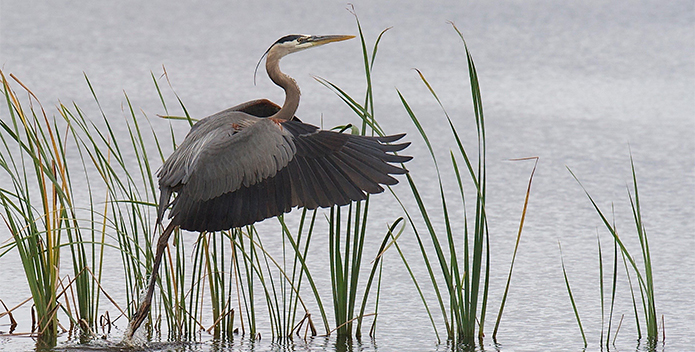
A great blue heron near Fones Cliffs on Virginia's Rappahannock River.
Bill Portlock/CBF Staff
Usually seen stalking fish in shallow waters, the great blue heron also hunts frogs, snakes, turtles, and small mammals along shorelines including those of Fones Cliffs. It is the largest wading bird in the Chesapeake Bay. Usually a solitary bird, great blue herons nest in colonies with other great blues and occasionally even with other heron and egret species. They are considered short-range migrants as the birds that are here in summer fly south and are replaced by northern great blues, a few of whom may remain in the Bay region during colder months—or just move farther south when extreme cold weather occurs and fish producing waters freeze.
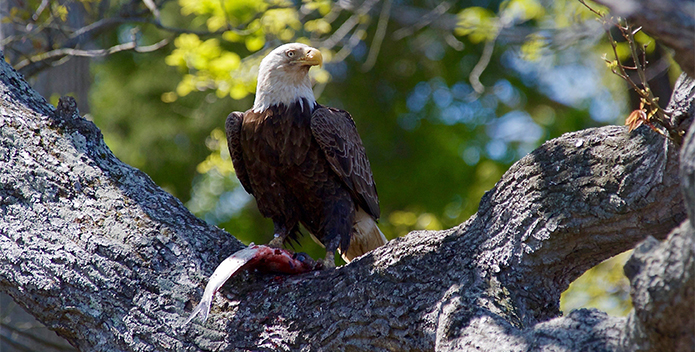
A bald eagle eating a fresh caught alewife near Fones Cliffs on Virginia's Rappahannock River.
Bill Portlock/CBF Staff
The Chesapeake Bay, and Fones Cliffs in particular, is a convergence area for many post-nesting adult and sub-adult bald eagles from the northeastern and southeastern United States. There is a large breeding population of bald eagles along the Rappahannock River and Fones Cliffs plays a significant role as a nexus of eagle movement in eastern North America.
In the late fall, eagles migrate south from New England and Canada to spend the winter months on the tributaries of the Bay in places called concentration areas. In late spring and early summer, sizeable numbers of post-breeding eagles migrate north from Florida to spend the summer months in the Bay. The convergence of these three geographically distinct populations of eagles suggests that Fones Cliffs plays a particularly important role in the recovery of bald eagles in eastern North America.
The bald eagle, pictured here with a freshly caught alewife, is the only eagle unique to North America. Its scientific name Haliaeetus leucocephalus means "white-headed sea eagle." Adult bald eagles are unmistakable with white head and tail feathers and usually a dark, uniform brown plumaged body. It takes four to five years for bald eagles to attain this mature plumage. Their 90-inch wingspan makes our national bird a most impressive species.
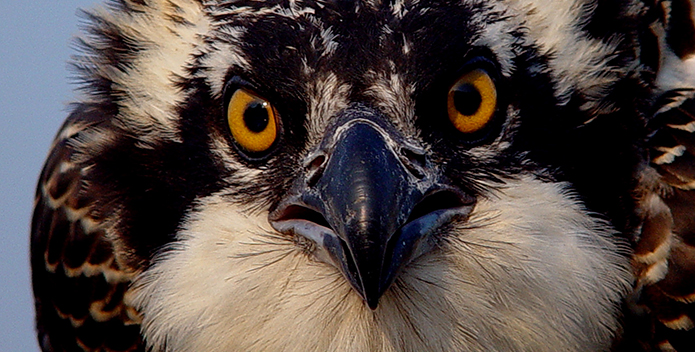
An osprey near Fones Cliffs on Virginia's Rappahannock River.
Bill Portlock/CBF Staff
An iconic bird of the Chesapeake Bay, the osprey is found on every continent on earth except Antarctica. Long narrow wings bending like "elbows" and white undersides and crown (in adults) make them easily identifiable. Ospreys spend spring and summer on the Chesapeake Bay and its many rivers. They leave the Bay around Labor Day, migrating southward to Florida to Venezuela and Brazil. Their diet is almost exclusively fish that are captured in waters up to a meter deep. The osprey population near Fones Cliffs forages heavily on gizzard shad and blue catfish. The osprey is a plunge diver that catches prey by immersing itself talons-first in the water. Unlike other hawks and eagles, Ospreys have a well-developed uropygial (oil) gland similar to waterfowl that provides natural waterproofing for their feathers. This waterproofing allows them to safely submerge completely in the water after their prey.
While Fones Cliffs is critically important habitat for the great blue heron, bald eagle, osprey, and other wildlife, it is a threatened landscape—
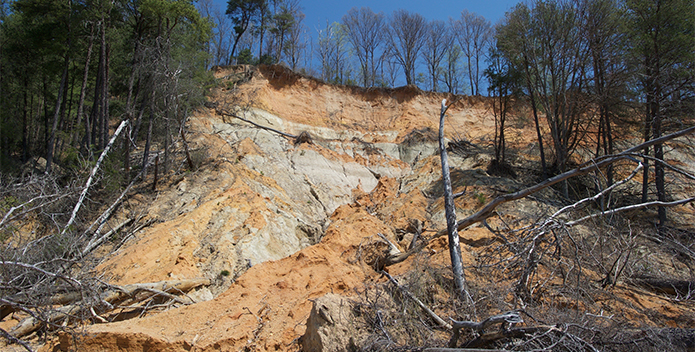
Erosion takes place on Fones Cliffs on Virginia's Rappahannock River.
Bill Portlock/CBF Staff
This photo from 2014 illustrates the cliff face of loose sediment bordering the Rappahannock. The whitish, highly erodible cliffs are composed of clay, silt, and sand combined with the tiny skeletons of ancient marine organisms called diatoms. Diatoms are microscopic organisms that secrete a bivalve shell. The shells are composed of silica, which, when mixed with clays, sands, or silts, are referred to as diatomaceous earth. Present day diatoms live in salt, brackish or fresh waters, and in peat bogs, moist soils, and even oceanic ice. At least partial exposure to sunlight is required for their existence. After death, diatoms sink to the bottom of waters where their organic body parts decompose. The external silica shells, however, are nearly indestructible, and these skeletal remains accumulate on sea floors. Fones Cliff sediments are the fossil remains from this diatomaceous sea, evidence of a much higher sea level that covered what is the Rappahannock today.
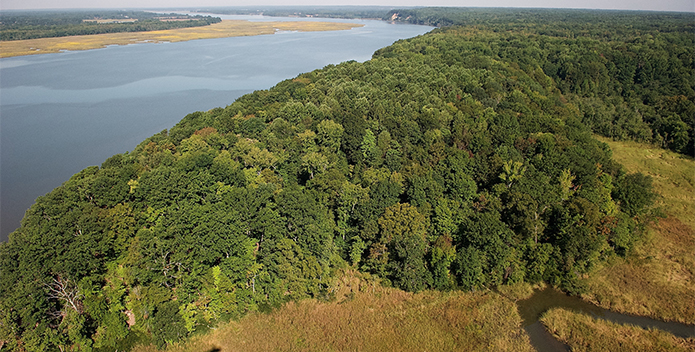
An aerial view of Fones Cliffs on Virginia's Rappahannock River.
Bill Portlock/CBF Staff
Verdant aerial photograph taken above Fones shows its intact forest cover in September 2015. Illegal clearcutting of 13.5 acres of trees imperils the integrity of the landscape and its value in protecting against erosion while offering an important non-fragmented forest habitat critical to certain wildlife species.
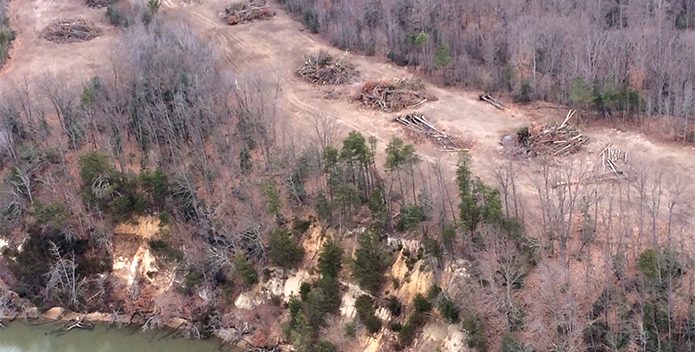
In late 2017, developers illegally cleared 13.5 acres of forest on Fones Cliffs without proper permits and environmental controls.
Chesapeake Conservancy
This photo reveals some of the damage caused by the illegal clearing of forest on Fones Cliffs. This damage was particularly shocking because during efforts to rezone the property two years ago the developer repeatedly promised to meet and even exceed all environmental safeguards. Yet, when the time came, the developer began felling trees and digging up the land without any of the required permits needed to ensure that polluted runoff did not reach the water.
Despite this setback, the good news is that Richmond County officials issued an emergency order stopping the work, and Virginia's Department of Environmental Quality (DEQ) has begun formal enforcement proceedings against the developer, known as Virginia True LLC.
We urge DEQ to use its enforcement powers to the maximum extent possible to deter future violations. In the coming weeks, we expect to see a proposed consent decree that lays out the steps the developer must take to get into compliance with the rules to protect the site. If so, there will be a chance for the public to submit comments to DEQ.
Stay tuned. We will keep you posted on opportunities to conserve this jewel of the Rappahannock.

